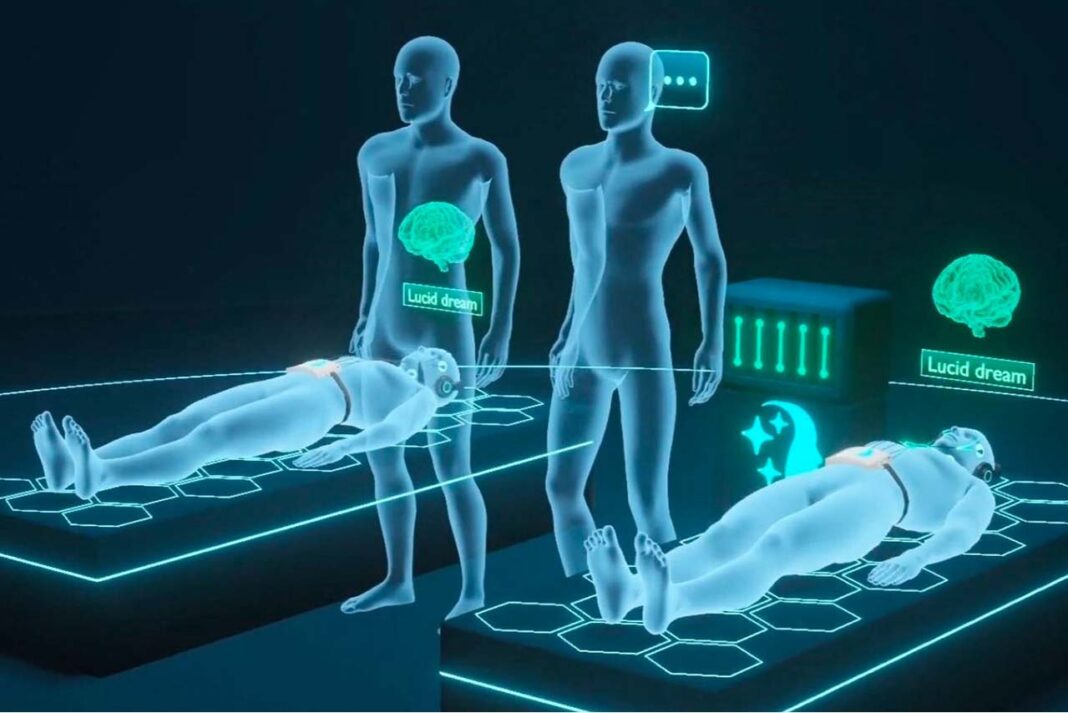Can Two Minds Meet Within The Same Dream Scene?
Realizing that you are not alone in a dream—does it reveal the limit of consciousness or its very beginning?
For a long time, such questions remained mere metaphoric thought experiments. The idea of contacting another mind within a dream was considered a science-fiction fantasy—until REMspace turned that vision into something tangible.
Last year, the Silicon Valley-based neurotechnology startup REMspace brought a phenomenon long confined to theory into the experimental realm. On September 24, 2024, during a groundbreaking study, two participants in REM sleep achieved something unprecedented:
The dreaming individual perceived a question transmitted from the external world and responded using prearranged eye movements.
Special EEG and EMG sensors tracked both brain activity and facial muscle movements in real time. The system developed by REMspace did not merely record — it transmitted signals into the dream itself.
For the first time, meaningful information exchange between two people during sleep was achieved.
This provided early evidence that external stimuli can be consciously processed during dreaming, enabling partial communication with the outside world.
This experiment is not only a technological milestone but also a threshold redefining the boundaries of consciousness. For years, “contacting another mind in a dream” was a metaphor, but REMspace made that contact measurable and reproducible.
The question is no longer “Can we communicate in a dream?” but rather, “What does consciousness reveal when we do?”
From A Cognitive Psychology Perspective: How Feasible Is Information Processing Within Dreams?
During lucid dreaming, the brain functions in a state distinct from classical REM sleep.
In most individuals, the prefrontal cortex remains partially active—meaning that attention, decision-making, and self-awareness are not fully shut down (Voss et al., 2009).
This enables the dreamer to both observe and direct the dream.
According to REMspace’s findings, external stimuli can seep through this cognitive window.
The perception of words during dreaming demonstrates that the auditory cortex and other sensory systems remain active even in REM sleep.
In other words, the mind does not become passive while dreaming; perceptual integration and information processing continue (Stickgold, 2013).
The Emergence Of Remmyo: A Cognitive Interface For Dreams
In their experiments, the REMspace team developed a special linguistic system called Remmyo, designed to facilitate communication during dreams.
This system consisted of phonetic units with high perceptual clarity and low cognitive load, optimized for comprehension in the dreaming state.
The words in Remmyo were modeled to be phonetically simple, high-frequency, and cognitively light, making them easier to process and recall while dreaming.
This approach aligns with Sweller’s (1988) Cognitive Load Theory and Cowan’s (2001) models of short-term memory and emotional processing.
In essence, Remmyo is not merely an artificial language—it is a cognitive interface optimized for the dream environment.
The Future Of Dream Communication And Psychotherapy
REMspace’s long-term goal is to enable not just one-way signaling, but fully bidirectional, real-time dream communication.
If realized, this could have revolutionary implications not only for neurotechnology but also for psychology and psychotherapy.
Imagine a scenario where a traumatic memory is reframed — not while awake — but within the dream itself.
A client could actively reshape subconscious scenes in real time.
In that case, psychotherapy would no longer rely solely on conscious awareness, but also on cognitive processing that occurs within dreams.
Similarly, the concept of in-dream learning would reach a new dimension.
The consolidation of a word or concept learned during sleep could be accelerated through optimized sensory pathways, such as those designed in the Remmyo system.
And perhaps the most intriguing possibility: dreams might evolve from isolated personal experiences into collective creative spaces.
At that point, the real question becomes: Can multiple minds meet in the same dream scene?
Consciousness Beyond Sleep: The Redefined Boundary
All of this suggests that dreams are not a passive state of consciousness, but rather an active form of cognitive interaction.
REMspace’s experiment blurs the line between dreaming and wakefulness, prompting us to reconsider not where consciousness ends, but where it begins again.
Lucid dreaming appears not as a shutdown of awareness, but as its expansion into a new dimension.
And perhaps, in the not-so-distant future, dreams will no longer be solitary experiences, but shared stages of a collective mind.
References
Cowan, N. (2001). The magical number 4 in short-term memory: A reconsideration of mental storage capacity. Behavioral and Brain Sciences, 24(1), 87–114.
How to have a Lucid Dream Tonight – Lucid Dreams and Out-of-Body Travels. REMspace.
REMspace achieves first ever lucid dream communication in history. Dataconomy.
Stickgold, R. (2013). Parsing the role of sleep in memory processing. Current Opinion in Neurobiology, 23(5), 847–853.
Sweller, J. (1988). Cognitive load during problem solving: Effects on learning. Cognitive Science, 12(2), 257–285.
Voss, U., Holzmann, R., Tuin, I., & Hobson, J. A. (2009). Lucid dreaming: A state of consciousness with features of both waking and non-lucid dreaming. Sleep, 32(9), 1191–1200.


